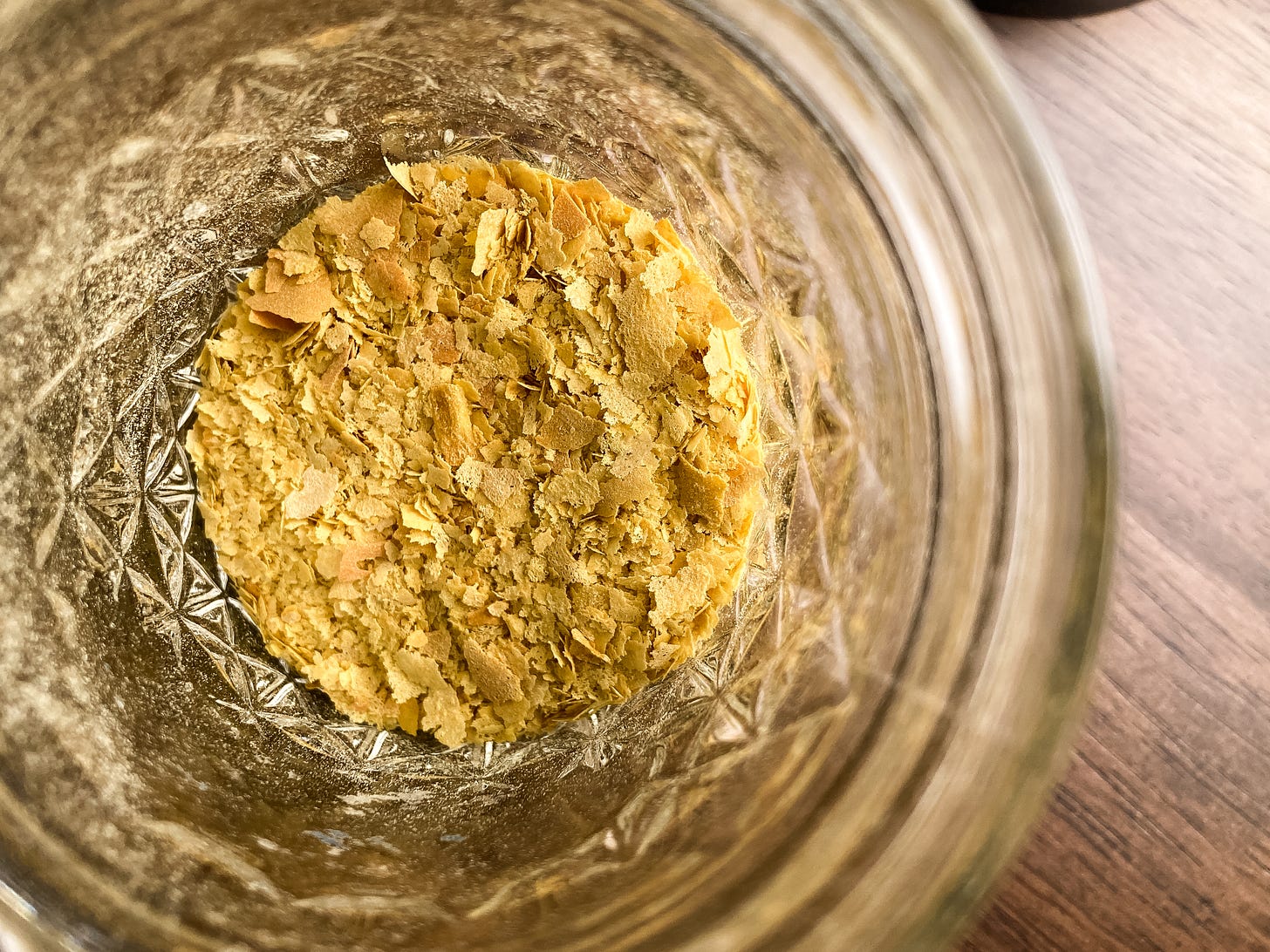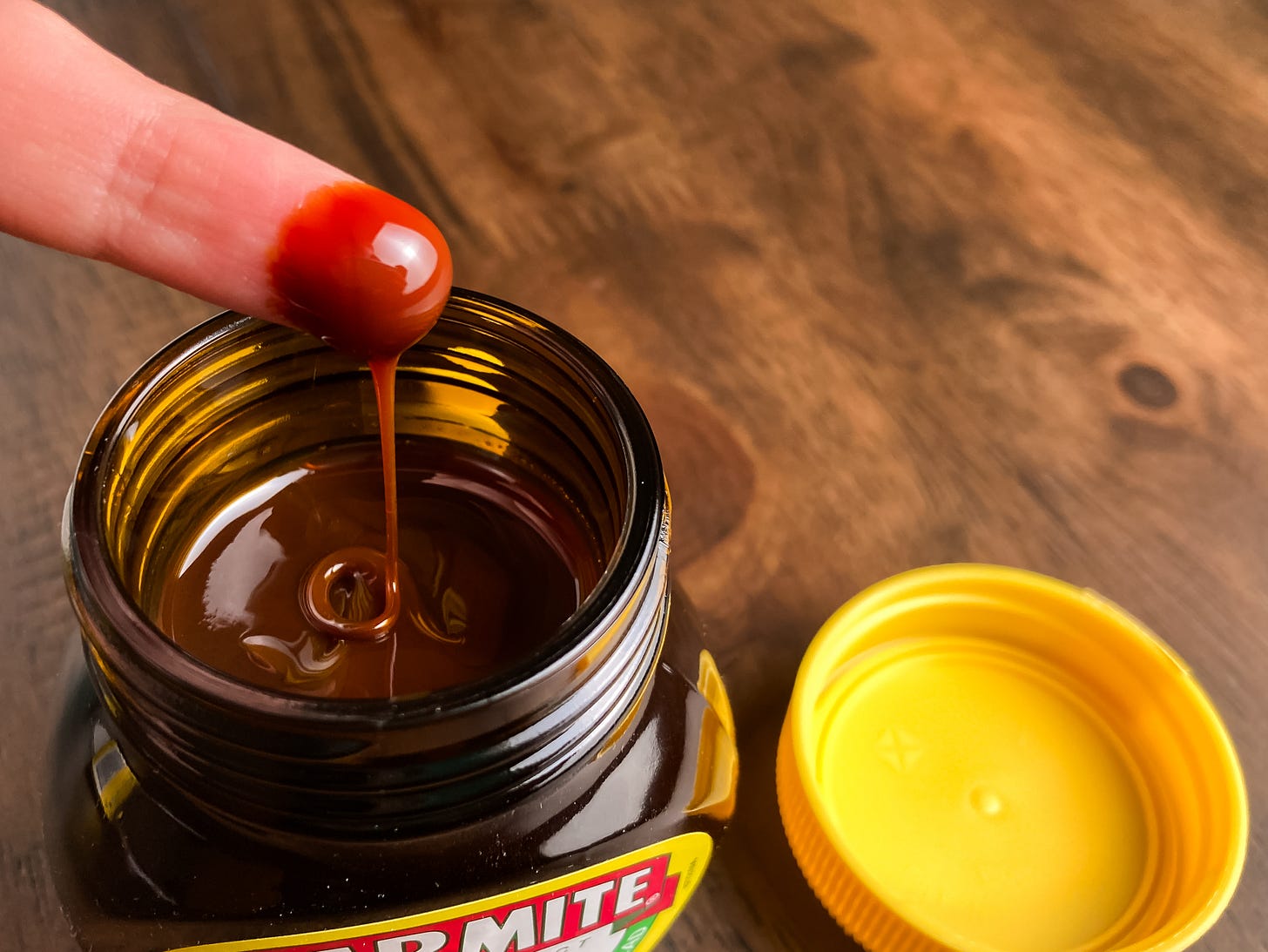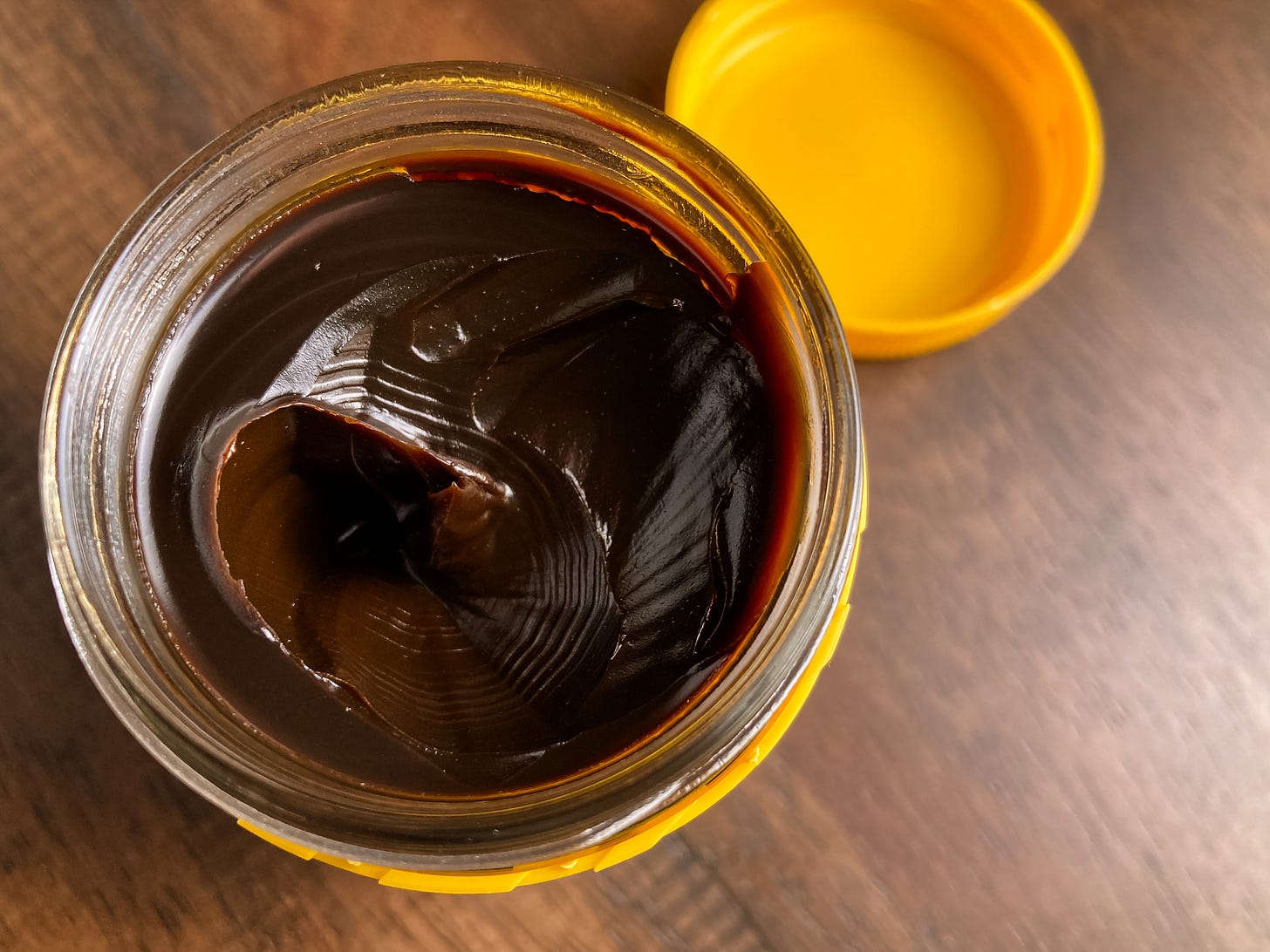It's the yeast I could do
I tasted three types of culinary yeast so you don't have to (but maybe you'll still want to?)
I’m not terribly tuned into what’s “trendy” in the food world these days. TikTok trends and viral recipes pass under my radar, mostly because I’ve turned my radar off. It’s honestly been a relief to step back from the chaotic noise of social media, which probably makes me sound old. (Have I said all this already? I can’t remember.) Another thing that probably makes me sound old is this: lately I’ve been thinking about nutritional yeast.
Yes, you may laugh. It’s such a cliche ingredient, emblematic of retro hippy veganism! But I feel like it’s been quietly popping up in more and more recipes. On top of that, I’ve been surprised to see Marmite and Vegemite suddenly appear in several grocery chains near me. Previously they’ve been only given shelf space in specialty shops, or only available online.
My first time trying nutritional yeast might have been in college—a classic “it tastes just like cheese” falsehood from a vegan roommate. It might generously be called “cheese-adjacent.” My first time trying the two ‘mites was definitely in culinary school. One of my classmates was British, and when she was shocked to hear that many of us had never tried either brand, she brought in two jars to share. I remember her laughing and claiming that she was a “bad Brit” because she preferred coffee over tea and Vegemite over Marmite. I also remember that when I tasted both I loved one and hated the other.
Thanks to my extended quest to make an affordable, homemade vegan mince, I’ve been reading a lot of ingredient labels and thinking a lot about plant-based savoriness. Yeast extract is a very common flavor additive in commercially made vegan meats, and I decided that I had to know: could Marmite, Vegemite, or nutritional yeast be the umami-packed secret ingredient my pantry has been missing?
Three types of culinary yeast
Nutritional Yeast
Unlike Marmite and Vegemite, nutritional yeast is not a yeast extract. It’s just yeast. Specifically, it is deactivated (aka, dead) yeast, usually a strain of Saccharomyces cerevisiae.
Using nutritional yeast, fondly called “nooch”, as a cheesy substitute is a fairly common trope in vegan cooking, but these days US markets are stocking more and more actual vegan cheese. Some are simple, meant to replicate a good ol’ Kraft American slice, while some are fancy, made through the culture and fermentation of non-dairy milks. (Not a recommendation, since I’ve no experience with the brand, but here’s an artisan example!)
So if we really don’t need nooch for vegan almost-cheesiness, why might we want it in our pantries?
From a structural viewpoint, it is a dry, shelf-stable source of umami, with more flavor complexity than MSG. The flavor is decidedly savory, with a somewhat nutty edge. If you’d like to bump up the savoriness without adding extra moisture, or you’d like some umami that is less deep and dark than many fermented soy products (shoyu, doenjang, etc), then nooch is a great option. Given its almost-cheesy character, it makes a good addition to creamy recipes, be they dairy-ful or dairy-free. The creamy gravy in a vegetarian pot pie, for example, would be a great application, as would a vegan or dairy-free quiche.
It does have an incredibly distinct flavor, however, and if used in large amounts that flavor will be quite noticeable in your recipe. If you love it and want to taste it then it’s not an issue, but if your goal is subtlety then you won’t want to sprinkle it in willy-nilly.
Fun fact: When given a light, dry toast, nooch takes on a smell that is remarkably similar to roasted chicken. (Credit to Richard Makin, aka The Schoolnight Vegan, for sharing this in his vegan “chicken” seasoning.)
♥♥♥
Hey hi hello! One of the best ways to show love for friends and family is through cooking, am I right? Well, let’s take that love and spread it as far as we can! Especially now, with all the horrors unfolding in the US and continued genocide abroad, let’s make a difference where we can by seeking out local nonprofits that support mutual aid endeavors like community fridges and advocacy for our unhoused neighbors. Support for organizations that provide critical support for Trans youth is also critical, as is finding ways to support anti-genocide efforts and relief aid in Palestine, such as through organizations like Anera. Because yes, it is genocide, and yes, it is still happening.
♥♥♥
Marmite
Marmite is a drizzly yeast extract made from the yeasty by-products of brewing beer. It’s thinner than molasses, but just as sticky. It’s naturally a good source of several B vitamins, but it also is fortified with extras, like B12.
The current slogan, born in the 90s, is simply “Love it or Hate it,” and the brand’s website welcomes you with a large banner asking, “Are you a Lover or a Hater?”
Marmite is incredibly pungent, something that is clear from the moment you open the jar. It smells dark and boozy, with an earthy something-something that immediately brings to mind dark soy sauce (assuming you’re already familiar with dark soy sauce) or mushroom bouillon.
The taste of marmite is similar to its smell, but in my opinion the booziness becomes more distinctly beer-y. Imagine a very bracing, almost astringent stout beer and you’ve got it. On top of that bitter edge, it’s deeply savory with a subtle funk that’s not unlike the pseudo-cheese yeast flavor of nooch.
These are some pretty aggressive descriptors, but keep in mind that marmite is incredibly concentrated. If you’re tasting it plain, just a dab will saturate your taste buds. And even though we usually associate descriptors like “bitter” with bad flavors, bitterness is a critical part of balancing taste, and is a key component in enhancing surrounding flavors. Chocolate, dark caramels, coffee, grilled or heavily seared food…All of these delicious things wouldn’t be nearly as good without their natural bitter notes, and that’s what marmite is contributing along with its savoriness.
Vegemite
Vegemite is also a yeast extract made from beer-making byproducts. It was created in Australia, theoretically when marmite imports from the UK were disrupted after WWI.
On the nose it’s nearly as pungent as marmite, but doesn’t seem to leap out of the jar in the same way. It, too, smells boozy and dark, but to me there is a malty smell that is reminiscent of sourdough starter residue. Appealing, no? I find it to be earthy like marmite, but less mushroomy and more vegetal. This makes sense, given that vegemite is supposed to have more veg added into its recipe.
Texturally it’s very smooth but much, much thicker than marmite, thicker even than peanut butter.
Overall, the flavor of vegemite is very savory, but with a surprising acidic note. While I wouldn’t call it sour, per se, the acidity and bitterness don’t quite harmonize with each other, creating a bit of a taste war when sampled plain. In some ways the flavor of vegemite is more beefy and meaty than marmite, but I also find the bitterness to tiptoe a bit closer to medicinal.
Basic Cook Test: Yeast extracts as broth substitute
Nooch is often used as a flavoring for popcorn, and both marmite and vegemite are famously eaten smeared on toast. But because of their overall flavor complexity and intensity, I’m personally less interested in using them as condiments and much more curious about how the three of them function as supporting ingredients.
Vegemite in particular smells an awful lot like the beef Better than Bouillon paste, so I decided to follow that association and use each of them as seasoning ingredients in one of the simplest ways possible: cooking white rice.
I made micro-batches with each ingredient, using 1/3 cup white rice, 4 grams of yeasty product, and just shy of 2/3 cup water. I did not add any salt. I didn’t expect any of them to be truly delicious when used this way, but I wanted to get a sense for how they behave in a fairly gentle cooking environment.
Vegemite:
Kind of a dusty, earthy savoriness. It has a sort of artificial undertone that was much less pronounced when I tasted it straight from the jar. Despite how salty vegemite is on its own, the rice was very bland. Adding a pinch of salt helped to wake it up a bit.
Marmite:
Overall better seasoning (salt) than the vegemite rice, and less of a dusty flavor. It tasted more like the rice had been cooked in your basic, admittedly insipid, boxed beef broth. A pinch of salt seemed to bring out some of the more bitter, dusty flavors, but it was generally brothy and pleasant.
Nooch:
Popcorny, buttery umami, but it was begging for salt. The flavor leaned more chicken broth-y, but the dominant flavor was just straightforward nutritional yeast. Not bad, but too one-note. (I did not try this with the toasted nooch a la Richard Makin, but I think I will at some point.)
Conclusions:
The marmite rice was the closest to tasting like it had been cooked in real broth, which, in my mind, makes it the winner. While I may not reach for it to flavor plain rice, I do think that the subtle beefy quality will make it a great alternative to beef bouillon, soy sauce, or Worcestershire sauce when adding oomph to more complex recipes like soups or gravies. If I ever decide to develope a homemade vegan burger patty I will definitely be reaching for marmite!
Rather than pitch the cooked rice leftover from this test, I mixed all three together and threw them into the fridge. A mouthful the next day tasted like what it was: a mix of rices cooked in separate umami broths. But when I used the rice as part of a chilled rice and bean salad for lunch a few days later, it was fantastic. The rice flavor mellowed out completely and harmonized with the punchy dressing, creating a subtle and savory base for the beans and fresh veggies.
I hope you enjoyed diving into these three yeasty umami-bombs with me. If I’ve made you curious enough to do a little side-by-side comparison of your own, my best advice is to start with a tiny taste. Once you know what to expect, it’s easy to appreciate how much flavor is crammed into the smallest dab, and it’s always fun to expand your pantry’s available umami-packed options!
xoxo
Julia







Interesting article about culinary yeast. Until today this was something I knew absolutely nothing about! As always, your writing style is spot on and holds my attention to the end. Thank you!
FANTASTIC email today. It answered so many questions I've only been passingly curious about, and now I'm fascinated. Thank you for sharing your whole process, observations, and the aftermath of how you used your samples later. Really a great read.